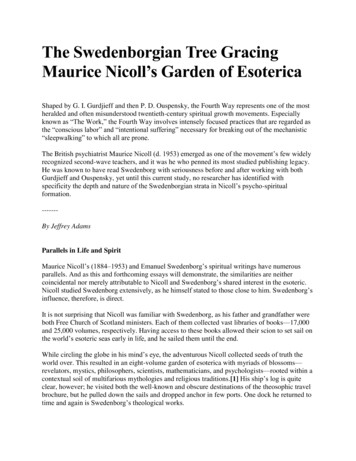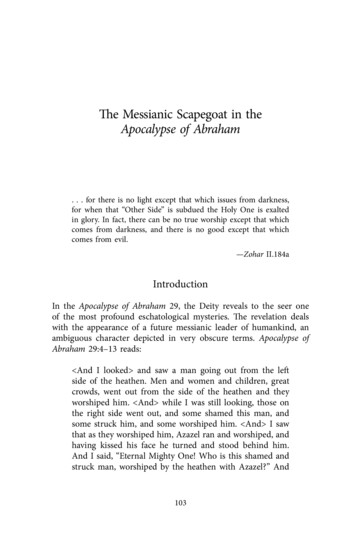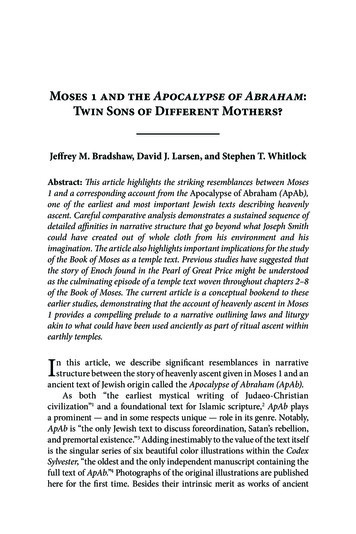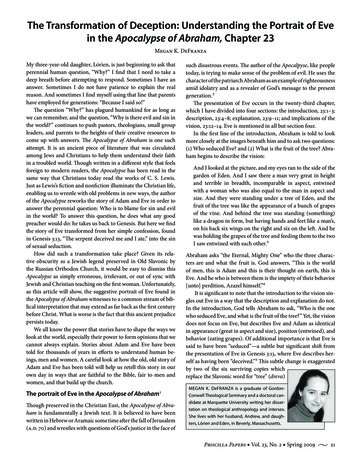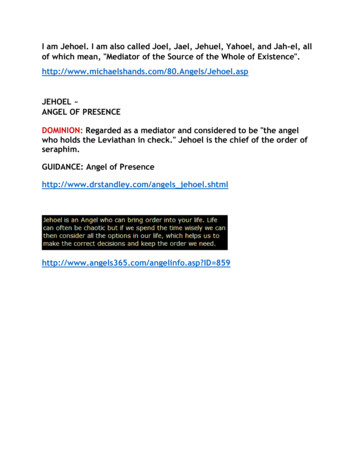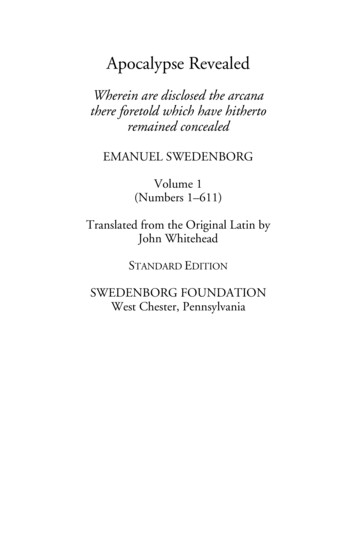
Transcription
Apocalypse RevealedWherein are disclosed the arcanathere foretold which have hithertoremained concealedEMANUEL SWEDENBORGVolume 1(Numbers 1–611)Translated from the Original Latin byJohn WhiteheadSTANDARD EDITIONSWEDENBORG FOUNDATIONWest Chester, Pennsylvania
2009 Swedenborg FoundationThis version was compiled from electronic files of theStandard Edition of the Works of Emanuel Swedenborg asfurther edited by William Ross Woofenden. Pagination ofthis PDF document does not match that of thecorresponding printed volumes, and any page referenceswithin this text may not be accurate. However, most if notall of the numerical references herein are not to pagenumbers but to Swedenborg’s section numbers, which arenot affected by changes in pagination. If this work appearsboth separately and as part of a larger volume file, itspagination follows that of the larger volume in both cases.This version has not been proofed against the original, andoccasional errors in conversion may remain. To purchase thefull set of the Redesigned Standard Edition of EmanuelSwedenborg’s works, or the available volumes of the latesttranslation (the New Century Edition of the Works ofEmanuel Swedenborg), contact the Swedenborg Foundationat 1-800-355-3222, www.swedenborg.com, or 320 NorthChurch Street, West Chester, Pennsylvania 19380.
ContentsEditor’s PrefaceAuthor’s PrefaceA Summary of the Doctrines of the Roman Catholic Church andReligionA Summary of the Doctrines of the Church and Religion of theReformedRevelation 1Revelation 2Revelation 3Revelation 4Revelation 5Revelation 6Revelation 7Revelation 8Revelation 9Revelation 10Revelation 11Revelation 12Revelation 13Critical Notes
APOCALYPSE REVEALED1Editor’s PrefaceApocalypse Revealed is a detailed unfolding of the inner or spiritualsense of the book of Revelation. This is the first of Swedenborg’slater works to which he appended so-called “memorable relations,”which are descriptions of otherworld events he witnessed. In 1765he had stopped writing in his Spiritual Diary—a work whichcontains much similar material—and now in this 1766 work (andall of his subsequent publications) he included accounts of suchhappenings. In a letter written to his friend Dr. Gabriel Beyer inApril 1766 he recommended that the doctor read these passagesfirst.This is the last work that Swedenborg published anonymously.Unlike his incomplete treatise, Apocalypse Explained, written earlierthan Apocalypse Revealed but published posthumously, this work isopenly addressed to the Christian world, and thus marks anapparently new attitude on Swedenborg’s part as to where the newchurch was to have its origin.This present edition was translated from the Latin by JohnWhitehead. The text was electronically scanned from theSwedenborg Foundation’s Standard Edition. This has allowed thebook to be completely redesigned and set in a new and morereadable typeface. Certain stylistic changes have also beenintroduced. These include modernized spelling and punctuation aswell as the substitution of new words for terms whose meaningshave become obscure or have changed since the nineteenth century.Arabic numerals have replaced roman numerals in Bible passages,and certain capitalized words, including pro nouns referring toGod, have been lowercased to reflect contemporary usage. All thesechanges have been carefully made in order to make the book easierto read and use while preserving the dignity and power of theoriginal Latin. On the whole, however, the Whitehead translationhas not been materially altered.A word needs to be said about the translation of the Scripturepassages in this work, some of which Swedenborg translated from
APOCALYPSE REVEALED2biblical Hebrew and Greek, others he cited from Latin Bibles in hispersonal library. The reader will note that the archaic language ofthe 1611 King James Bible, commonly called the AuthorizedVersion, has for the most part been retained in the Scripturecitations in this edition. Thus verbs will often have the suffix“-eth,” and pronoun forms such as “thee,” “thou,” and “thine” areretained. This custom, based on the almost universal use of theKing James version at that time, dates back to the earliest Englishtranslations of Swedenborg. The decision was made by the earlytranslators to follow the familiar language of that Bible wherever itdid not conflict with the Latin of Swedenborg’s Scripture citations.Although it would be desirable to update this language, thesecitations appear so frequently that changing them throughout theentire work would have required a major revision.Volume 1 of Apocalypse Revealed begins Swedenborg’s verse-byverse explanation, or commentary, of the biblical text of theApocalypse, commonly known as the book of Revelation or theRevelation of John. This volume covers chapters 1 through 13. Aswas the custom in his day, Swedenborg referred to the Psalms asthe book of David, and to the Pentateuch (Genesis, Exodus,Leviticus, Numbers, and Deuteronomy) as the books of Moses.Numbers indicating the paragraph subdivisions used in JohnFaulkner Potts’ six-volume Swedenborg Concordance (London:Swedenborg Society, 1888–1902) are inserted in this Americanedition for the first time. They appear in bracketed boldface type atthe beginning of paragraphs. The numbers in parentheses (6), (7),etc., are divisions of the exposition by the author. Italicized lettersfollowing a number (518a, 518b) are subdivisions added by theLatin editor, Samuel H. Worcester. Words or phrases in bracketsare also editorial insertions into Swedenborg’s text. Critical notes,referenced by superscripts in the text, will be found at the end ofthe volume.William Ross WoofendenSharon, Massachusetts
APOCALYPSE REVEALED3Author’s Preface[1] There are many who have labored in the explanation of theApocalypse [Book of Revelation], but, as the spiritual sense of theWord had been hitherto unknown, they could not see the arcanawhich lie concealed therein, for the spiritual sense alone disclosesthese; on which account expositors have conjectured various things,and the most of them have applied the things that are therein tothe states of empires, intermingling also some things aboutecclesiastical affairs. But the book of Revelation, like the wholeWord, does not in the least in its spiritual sense treat of worldlythings, but of heavenly things, thus not of empires and kingdoms,but of heaven and the church.[2] It is to be known that after the last judgment, which wasaccomplished in the spiritual world in the year 1757 (concerningwhich see material published in a small work in London in 1758),there was formed a new heaven from Christians; but only fromthose who could receive the Lord as the God of heaven and earth,according to his words in Matthew 28:18, and who at the sametime in the world had repented of their evil works. From thisheaven a new church on earth, which is the new Jerusalem, isdescending and will descend. That this church will acknowledgethe Lord alone is manifest from these passages in the book ofRevelation:There came unto me one of the seven angels and spoke with me, saying,Come, I will show you the bride, the lamb’s wife; and he showed me the greatcity, holy Jerusalem, coming down out of heaven from God (Rev. 21:9–10).And in another place:Let us rejoice and exult; for the time of the marriage of the lamb is come,and his wife hath made herself ready. Happy are they that are called unto themarriage supper of the lamb (Rev. 19:7, 9).
APOCALYPSE REVEALED4That there is to be a new heaven and that the new church onearth will descend therefrom is manifest from these words there:I saw a new heaven and a new earth; and I saw the holy city Jerusalemcoming down from God out of heaven, prepared as a bride adorned for herhusband. He that sat upon the throne said, Behold, I make all things new;and he said unto me, Write, for these words are true and faithful (Rev.21:1–2, 5).The “new heaven” is the new church from Christians; the “newJerusalem” is the new church on earth, which will act as one withthat new heaven. The “lamb” is the Lord as to the divine human.[3] To this something will be added for illustration. TheChristian heaven is below the ancient heavens. Into it, from thetime of the Lord, when he was in the world, were admitted thosewho worshiped one God under three persons, and who at the sametime did not have an idea of three gods; and this was because thetrinity of persons had been received in the whole Christian world.But they who cherished no other idea of the Lord’s human than asthe human of another man could not receive the faith of the newJerusalem; which is that the Lord is the only God in whom is thetrinity. These were for that reason separated and sent away to theextremes; it was given me to see the separations and the removalsafter the last judgment. For the whole heaven is founded upon ajust idea of God, and the whole church on earth, and in general allreligion; since by that idea there is conjunction, and by conjunctionlight, wisdom, and eternal happiness.[4] Everyone can see that the book of Revelation can by nomeans be explained except by the Lord alone; for each word thereincontains arcana, which could never be known without a particularenlightenment, and thus revelation; wherefore it has pleased theLord to open the sight of my spirit and to teach me. Do notbelieve, therefore, that I have taken anything therein from myself,nor from any angel, but from the Lord alone. The Lord also said toJohn through an angel:Seal not the words of the prophecy of this book (Rev. 22:10).By which is meant that they are to be made manifest.
APOCALYPSE REVEALED5A Summary of the Doctrinesof the Roman Catholic Church and ReligionSince Babylon, which is the Roman Catholic religion, is alsotreated of in Revelation, chapters 17, 18, and 19, in the beginningof these explanations, its doctrinal tenets must be laid open, and inthe following order: of baptism, the eucharist or holy supper,masses, repentance, justification, purgatory, the seven sacraments,the saints, and power.“1. Of baptism, they teach: that Adam, after the offense oftransgression, was wholly changed for the worse, both as to bodyand soul; that this sin was transfused into the whole human race;that this original sin is taken away only by the merit of Christ; andthat the merit of Christ is applied by the sacrament of baptism; andthat thus the whole guilt of original sin is taken away by baptism;that nevertheless lust remains in the baptized as an incentive tosins, but not sin itself; that thus they put on Christ, become newcreatures, and obtain a full and complete remission of sins. Baptismis called the laver of regeneration and of faith. That the baptized,when grown up, are to be questioned concerning the promisesmade by their sponsors; which is the sacrament of confirmation.That by reason of lapses after baptism, the sacrament of repentanceis necessary.“2. The eucharist or holy supper. That immediately afterconsecration, the true body and the true blood of Jesus Christ arereally and substantially contained under the form of bread andwine, together with his soul and divinity; the body under the formof bread, and the blood under the form of wine, by virtue of thewords: but the body itself under the form of wine, and the bloodunder the form of bread, and the soul under both, by virtue of anatural connection and concomitance, whereby the parts of theLord Christ are united together, and the divinity by reason of its
APOCALYPSE REVEALED6admirable hypostatic union with the body and the soul; thus thatthey are as fully contained under one form as under both; in aword, that the whole and entire Christ exists under the form of thebread and under every part of that form; and the whole also underthe form of the wine and its parts; that therefore the two forms areseparated, and the bread is given to the laity, and the wine to theclergy. That water is to be mixed with wine in the cup. That thelaity are to receive the communion from the clergy, and the clergyfrom themselves. That the true body and the true blood of Christ,after consecration, are in the host in the consecrated particles; andthat therefore the host is to be adored when it is shown and carriedabout. That this wonderful and particular conversion of the wholesubstance of the bread into body, and of the whole substance of thewine into blood, is called transubstantiation. That the communionof both forms, under certain conditions, may be granted by thepontiff. It is called supersubstantial bread, and the bread of angels,which these eat without any veils; it is also called spiritual food; alsothe antidote by which they are freed from sins.“3. Masses. It is called the sacrifice of the mass, because thesacrifice by which Christ offered up himself to God the Father, isrepresented thereby under the form of the bread and wine; thatthence it is a sacrifice truly propitiatory, pure, and there is nothingin it except what is holy. That if the people do not communesacramentally, but only the minister, then the people communespiritually, because the ministers do it, not for themselves only, butfor all the faithful who appertain to the body of Christ. The massesought not to be performed in the vulgar tongue, because theycontain the great learning of the faithful people; but that theministers may declare some thing concerning it on the Lord’s days.That it is ordained, that some things which are mystical should bepronounced with a lower, and other things with a louder, voice;and, for the purpose of giving majesty to so great a sacrifice whichis offered to God, there should be lights, incense, garments, andother like things. That it is to be offered for the sins, penalties,satisfactions, and all the necessities of the living, and also for thedead. That masses in honor of the saints are thanksgivings becausethey intercede when they are implored.
APOCALYPSE REVEALED7“4. Repentance. That besides baptism there is the sacrament ofrepentance, whereby the benefit of the death and merit of Christ isapplied to those who lapse after baptism; therefore it is called akind of laborious baptism. That the parts of repentance arecontrition, confession, and satisfaction. That contrition is the giftof God, and the impulse of the Holy Spirit, not yet indwelling, butonly moving, therefore it is a disposing. That confession ought tobe made of all mortal sins, even the most secret, and of theintentions; that sins which are withheld from confession are notforgiven, but that those which after search do not occur, areincluded in confession; that confession ought to be made at leastonce a year: that absolution of sins is to be given by the ministers ofthe keys, and that they are forgiven on their saying, I absolve; thatabsolution is like the act of a judge when sentence is pronounced;that the more grievous sins are to be absolved by bishops, and thestill more grievous by the pontiff. Satisfaction is made bysatisfactory punishments imposed by the ministry at discretion,according to the measure of the offense; that when eternalpunishment is remitted, then temporal punishment is remittedalso. That the power of indulgences was left by Christ to thechurch, and that the use of them is most salutary.“5. Justification. That the change from that state in which man isborn a son of Adam, cannot be effected into a state of gracethrough the second Adam the Savior, without the washing ofregeneration and faith, or without baptism. That the secondbeginning of justification is from preventing grace, which is acalling, with which man cooperates by converting himself. Thatdisposition is produced by faith, when man believes those things tobe true which are revealed, to which he is freely moved; also byhope, when he believes that God is propitious for the sake ofChrist; and by charity, in consequence whereof he begins to lovehis neighbor, and to hate sin. That justification, which follows, isnot only remission of sins, but sanctification, and renovation of theinterior man; that then they are not reputed just, but that they arejust, receiving justice in themselves; and because they receive themerit of Christ’s passion, justification is inserted by faith, hope,and charity.
APOCALYPSE REVEALED8[2 ] “That faith is the beginning of human salvation, thefoundation and root of justification, and that this is to be justifiedby faith: and because none of those things which precedejustification, whether they be of faith or works, merit the grace ofjustification, that this is being justified gratis, for it is a preventinggrace; and that still man is justified by works, and not so much byfaith. That the just may fall into light and venial sins, and still bejust; and that therefore the just ought continually to labor byprayers, oblations, alms, and fastings, lest they should fall, becausethey are born again into the hope of glory, and not into glory. Thatthe just, if they fall from the grace of justification, may be justifiedagain by the sacrament of repentance: that by any mortal sin graceis lost, but not faith, but that faith also is lost by infidelity, which isa receding from religion. That the works of a justified man aremerits; and that the justified merit eternal life by those that aredone by them through the grace of God and the merit of Christ.That free-will was not lost and extinguished after the sin of Adam;and that man cooperates by assenting to the calling of God; andthat otherwise he would be an inanimate body. They establishpredestination, by saying that no one knows whether he is in thenumber of the predestined, and among those whom God haselected to himself, except by special revelation.“6. Purgatory. That all the guilt from which men are to bepurified by temporal punishment is not blotted out by justification,and therefore all come into purgatory to be purified, before theentrance into heaven is open. That the souls there detained areassisted by the suffrages of the faithful, and particularly by thesacrifice of the mass; and that this is diligently to be taught andpreached. The torments there endured are variously described, butthey are inventions, and in themselves fictions.“7. The seven sacraments. That there are seven sacraments,baptism, confirmation, the eucharist, repentance, extreme unction,order, and matrimony; that there are neither more nor less: thatone is of greater dignity than another; that they contain grace; andthat from the work operated by them grace is conferred; that therewere the same number of sacraments of the ancient law. Baptism,
APOCALYPSE REVEALED9confirmation, the eucharist, and repentance have been treated ofabove. The sacrament of extreme unction: that it is founded on theepistle of James, chap. 5:14–15; that it is to be administered to thesick near the end of life, whence it is called the sacrament of thedeparting; that if they recover, it may be applied again; that it isperformed with oil blessed by the bishop, and with these words: May God grant thee indulgence for whatsoever offense thou hastcommitted through the fault of the eyes, the nostrils, or the touch.’The sacrament of order: that there are seven orders in the ministryof the priesthood, which differ in dignity, and all together arecalled the ecclesiastical hierarchy, which is like the order of anencampment; that inaugurations into the ministry are to beeffected by anointings, and by transferring of the Holy Spirit intothem. That the secular power or consent, calling or authority of themagistrate is not required for the ordination of bishops and priests;that they who ascend to the ministry being appointed by a callingfrom them only, are not ministers, but thieves and robbers, who donot enter in by the door. The sacrament of matrimony: that thedispensation of degrees and divorces belongs to the church. Thatthe clergy are not to contract matrimony. That all of them mayhave the gift of chastity, and if anyone saith he cannot, whennevertheless he has vowed, let him be anathema, because God doesnot refuse it to those who seek it in a right way, and does not sufferanyone to be tempted beyond what he is able to bear. That a stateof virginity and celibacy is to be preferred to the conjugial state;besides other things.“8. The saints. That the saints reigning together with Christ offerup their prayers to God for men; that Christ is to be adored, andthe saints to be invoked; that the invocation of saints is notidolatrous, nor derogatory to the honor of the one mediatorbetween God and men; it is called latria. That images of Christ, ofMary the God-bearer and of the saints, are to be revered andhonored; not that it is to be believed that there is divinity or virtuein them, but because the honor which is paid to them is referred tothe prototypes which they represent; and that through the imageswhich they kiss, and before which they kneel and uncover their
APOCALYPSE REVEALED10heads, they adore Christ and venerate the saints. That the miraclesof God are performed through the saints.“9. Power. That the pope of Rome is the successor of the apostlePeter, and vicar of Jesus Christ, the head of the church, and theuniversal bishop; that he is above councils; that he has the keys toopen and shut heaven, consequently the power of remitting andretaining sins; that therefore he, as key-bearer of everlasting life,hath a right at once to earthly and heavenly empire; that moreoverbishops and priests have such a power from him, because it wasgiven also to the rest of the apostles, and that therefore they arecalled ministers of the keys. That it belongs to the church to judgeof the true sense and interpretation of the sacred Scripture, and thatthey who oppose them are to be punished by penalties establishedby law. That it is not fitting for the laity to read the SacredScripture, because the sense of it is only known to the church;thence its ministers make traffic of their knowledge of it.”10. The above are from councils and bulls, particularly from thecouncil of Trent, and the papal bull confirming it, wherein all whothink, believe, and act contrary to what was there decreed, which ingeneral is as above adduced, they condemn by anathema.A Summary of the Doctrinesof the Church and Religion of the ReformedSince the Reformed are much treated of in Revelation in itsspiritual sense, therefore, before entering upon the explanations,their doctrinal tenets are also to be laid open, and in this order: ofGod, of Christ the Lord, of justification by faith, and of goodworks, of the law and the gospel, of repentance and confession, oforiginal sin, of baptism, of the holy supper, of free-agency, and ofthe church.
APOCALYPSE REVEALED11“1. Of God. Of God they believe according to the AthanasianCreed, which, as it is in the hand of everyone, is not here quoted.That they believe in God the Father as the creator and preserver; inGod the Son as the savior and redeemer; and in the Holy Spirit asthe enlightener and sanctifier, is also known.“2. Of Christ the Lord. Concerning the person of Christ, thesame doctrine is not taught by all the Reformed. The Lutheransteach that the virgin Mary not only conceived and brought forth areal man, but also the real son of God, whence she is rightly called,and truly is, the mother of God. That in Christ there are twonatures, the Divine and the human, the Divine from eternity, andthe human in time; that these two natures are personally united,altogether in such a manner, that there are not two Christs, one theson of God, and the other the son of man; but that one and thesame is the son of God and the son of man, not that these twonatures are mixed together into one substance, nor that one ischanged into the other, but that both natures retain their essentialproperties, which are also described as to their qualities; that theirunion is hypostatic, and that this is the most perfect communion,like that of the soul and body; that therefore it is rightly said, thatin Christ God is man and man God.[2] “That he did not suffer for us as mere man only, but as suchman, whose human nature has so strict and ineffable a union andcommunion with the son of God, as to become one person withhim; that the son of God truly suffered for us, but yet according tothe properties of the human nature; that the son of man, by whomis meant Christ as to the human nature, was really exalted to theright hand of God when he was taken into God, which was the caseas soon as he was conceived of the Holy Spirit in the womb of themother; that Christ always had that majesty by reason of thepersonal union, but that, in the state of exinanition, he onlyexercised it so far as seemed good to him; but that after theresurrection he fully and entirely put off the form of a servant, andestablished the human nature or essence in the plenary possessionof the Divine majesty; and that in this manner he entered intoglory; in a word, Christ is, and remains to all eternity, perfect God
APOCALYPSE REVEALED12and man in one indivisible person; and the true, omnipotent andeternal God; being, also with respect to his human, present at theright hand of God, he governs all things in the heavens and onearth, and also fills all things, is with us, and dwells and operates inus. That there is no difference of adoration, because through thenature which is seen, the divinity which is not seen, is adored. Thatthe Divine essence communicates and imparts its own excellencesto the human nature, and performs its Divine operations throughthe body as through its organ; that thus all the fullness of thedivinity dwells in Christ bodily, according to Paul.[3] “That the incarnation was accomplished that he mightreconcile the Father to us, and become a sacrifice for the sins of thewhole world, as well original as actual; that he was incarnated fromthe substance of the Holy Spirit, but that his human nature wasproduced from the virgin Mary, which, as the Word, he assumedand united to himself; that he sanctifies those who believe in him,by sending the Holy Spirit into their hearts, to rule, comfort, andvivify them, and defend them against the devil and the power ofsin. That Christ descended to those below, and destroyed hell forall believers; but in what manner these things were effected, he doesnot wish them to scrutinize too curiously, but that the knowledgeof this matter may be reserved for another age, when not only thismystery, but many other things also will be revealed.” Theseparticulars are from Luther; the Augustan Confession; the NiceneCouncil, and the Smalcaldic Articles. See the Formula Concordiae.[4] “By another part of the Reformed, who are also treated of inthe Formula Concordiae, it is believed that Christ, according to hishuman nature, by exaltation, received only created gifts and finitepower, therefore that he is a man like any other, retaining theproperties of the flesh; that therefore as to his human nature he isnot omnipresent and omniscient; that although absent he governs,as King, things remote from himself; that as God from eternity heis with the Father, and as Man born in time, he is with the angelsin heaven; and that when it is said, in Christ God is Man and ManGod, it is only a figure of speech; besides other things of a likenature.
APOCALYPSE REVEALED13[5] “But this disagreement is adjusted by the Athanasian Creed,which is received by all in the Christian world, where these wordsoccur: ‘The true faith is, that we believe and confess that our LordJesus Christ, the son of God, is God and Man; God, from thesubstance of the Father, born before the world, and Man, from thesubstance of the mother, born in the world; perfect God andperfect man: who, although he be God and man, yet they are nottwo but one Christ: one, not by the conversion of the Divineessence into body, but by the taking of his human into God; onealtogether, not by confusion of substance, but by unity of person;for as the rational soul and the body is one man, so God and Manis one Christ.’“3. Of justification by faith, and of good works. The justifyingand saving faith of the clergy is this: that God the Father turnedhimself away from the human race on account of their iniquities,and so, from justice, condemned them to eternal death, and that hetherefore sent the son into the world to expiate and redeem them,and to satisfy and reconcile; and that the son did this by takingupon himself the condemnation of the law, and suffering himself tobe crucified, and that thus by obedience he entirely satisfied God’sjustice, even to becoming justice himself; and that God the Fatherimputes and applies this, as his merit, to believers, and sends theHoly Spirit to them, who operates charity, good works, andrepentance, as a good tree produces good fruits; and justifies,renews, regenerates, and sanctifies; and that this faith is the onlymeans of salvation, and that by it alone a man’s sins are forgiven.[2 ] “They distinguish between the act and the state ofjustification; by the act of justification they understand thebeginning of justification, which takes place in a moment, whenman by that faith alone takes hold of the merit of Christ withconfidence; by the state of justification they understand theprogress of that faith, which takes place by the interior operation ofthe Holy Spirit, which does not manifest itself except by certainsigns, concerning which they teach various things. They speak alsoof manifest good works, which are done from the man and his will,and follow that faith; but they exclude them from justification,
APOCALYPSE REVEALED14because the proprium and therefore the merit of the man is inthem.[3] “This is a summary of modern faith, but its confirmationsand the traditions concerning it are numerous and manifold; someof which also shall be adduced; which are, that men cannot bejustified before God by their own strength, merits, and works, butgratuitously for Christ’s sake, by faith; that by this faith theybelieve that they are received into grac
Volume 1 of Apocalypse Revealed begins Swedenborg’s verse-by-verse explanation, or commentary, of the biblical text of the Apocalypse, commonly known as the book of Revelation or the Revelation of John. This volume covers chapters 1 through 13. As was the custom in his d
